Essential Nutritional Guide for Bearded Dragons

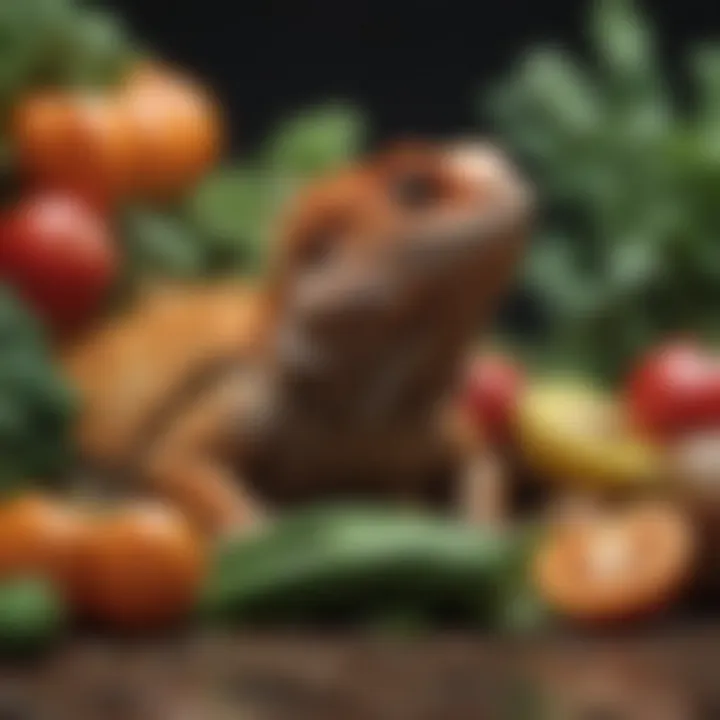
Intro
Understanding the dietary needs of bearded dragons is crucial for their health and longevity. These fascinating reptiles require a carefully balanced diet to thrive. In this article, we will explore daily dietary recommendations tailored to bearded dragons, focusing on key aspects such as proper nutrition, hydration, and calcium supplementation. Whether you're a longtime owner or considering adopting a bearded dragon, this guide offers valuable insights to ensure these pets receive the best care possible.
Care Tips
Daily Care Routines
Routine is essential in a bearded dragon's life. A consistent schedule helps manage their diet effectively. Aim to feed them twice daily, adjusting portions based on age and health status. Young dragons need more frequent feeding compared to adults.
It's also important to monitor their habitats for temperature and humidity. The basking area should remain at a comfortable warmth of about 100 to 110 degrees Fahrenheit, while the cool end should be around 80 degrees.
Hydration is an overlooked aspect. Offer fresh, clean water daily. Some bearded dragons may enjoy drinks directly from a shallow dish. Others may require a fine misting or occasional baths to stay hydrated.
Cage Setup and Maintenance
A well-designed habitat contributes to their nutritional success. Ensure your bearded dragon’s enclosure has adequate space and proper temperature zones. Use environmentally friendly substrates that are easy to clean, like reptile carpet or tiles.
Maintaining cleanliness is vital. Daily spot cleaning the substrate helps control odor. A complete cleaning of the tank, including decor, should happen weekly, using safe disinfectants and rinsing thoroughly.
Hygiene and Cleaning Practices
Proper hygiene prevents health issues. Besides daily and weekly cleaning routines, always wash your hands after handling food and cleaning the tank. Prevent cross-contamination by designating specific tools for the bearded dragon’s care.
Seasonal Care Adjustments
Seasonal changes can affect dietary needs. In winter, when reptiles become less active, diet proportions may require adjustments, reducing the number of insects and focusing more on leafy greens with subsequent hydration considerations.
Nutrition Guides
Essential Diet Components
A balanced diet includes a mix of vegetables, fruits, and protein. Recommended leafy greens include collard greens and dandelion leaves. For protein sources, live insects like crickets and mealworms create dietary diversity and essential nutrients.
Safe and Toxic Foods
Not all foods are suitable for bearded dragons. Instead of generalizing, as a responsible owner, you must educate yourself on what is non-toxic.
Safe options:
- Bell peppers
- Squash
- Tomatoes
Foods to avoid:
- Avocado
- Onions
- Rhubarb
Supplements and Treats
Calcium and vitamin D3 are critical to prevent metabolic bone disease. Calcium powder can be sprinkled on food multiple times a week, allowing for enrichment through properly administered supplements.
Make treats rare but enticing! Fruits like strawberries or pineapple can make interesting additions but should be used sparingly, due to high sugar content.
Feeding Strategies for Different Species
Understanding the differences between subspecies is essential. Some juvenile species might require more protein; adult counterparts prefer a more herbivorous focus. Adjust foods according to their specific requirements, and consult reliable sources for more tailored information.
Balancing nutrition in bearded dragons involves a varied assortment of food sources to replicate their natural diet as closely as possible. Ensure a blend of green leafy vegetables and appropriate insects, maximizing their dietary intake.
Wellness and Health
Regular health checkups ensure dietary needs are being met adequately. If a bearded dragon shows significant changes in behavior or appetite, it could indicate health issues or nutritional deficiencies. Adequate supplementation can complement diets, especially in growing dragons.
Identifying symptoms early is key. Look for potential signs often linked to inadequate nutrition—listlessness, weight loss, and poor skin shedding. Preventative measures go beyond diet, considering also the stability of their environment and general treatment protocols.
Enriching Activities
Daily enrichment activities should support overall well-being. Simple toys and structures promote active play, encouraging physical exertion. Train your dragons gently using positive reinforcement, recognizing behaviors with appropriate treats or praise.
Outdoor activity should be conducted safely. Supervised time in the yard can provide sun exposure and stimulate mental engagement. Such outings offer holistic benefits, treating both body and psyche.
Being mindful of hydration ensures bearded dragons remain energetic and healthy. Pay attention to signs of dehydration—sunken eyes or lethargy should not be overlooked.
Understanding Bearded Dragon Nutrition
Nutritional requirements for bearded dragons revolve around several critical factors to ensure optimal health. Effective care for these reptiles mandates a comprehensive understanding of their dietary needs, which vary with their age and development stage. Ignoring specific nutritional essentials leads to health issues, thus showcasing the importance of a balanced and well-informed diet.
The Importance of a Balanced Diet
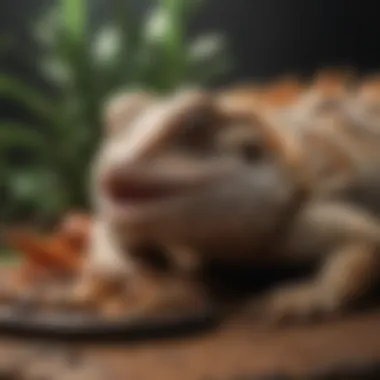
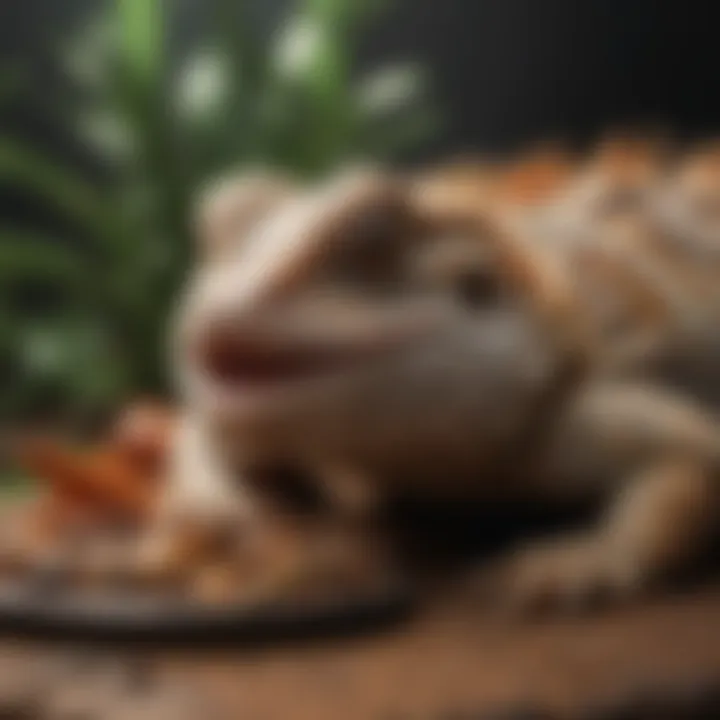
A balanced diet for bearded dragons significantly supports their growth, digestion, and overall vitality. Just like all pets, bearded dragons require a variety of nutrients at different life stages. They need proteins, vitamins, and minerals in precise proportions to maintain their health and well-being. Each food component serves a unique purpose. For instance, vegetables provide essential vitamins, while insects offer necessary proteins.
A well-rounded plan addresses not just immediate hunger but nurtures a stable and thriving body through thoughtful diet choices.
Exploring diverse food sources prevents boredom and stimulates natural behavior essential to their well-being. Furthermore, well-structured nutrition fosters healthier skin, vibrant colors, and stronger immunity against diseases.
Dietary Needs by Age
Optimal diet during the various life stages of bearded dragons helps foster appropriate development. Juvelinine, adult, and senior dragons share some needs while also having distinctive requirements.
Juvenile Bearded Dragons
Juvenile bearded dragons, those under 6 months of age, exhibit rapid growth and require rigorous nutritional inputs. They thrive on an abundance of proteins, primarily from insects. Crickets, mealworms, and dubia roaches are prime selections for this demographic. This emphasis on protein is because juveniles require more nutrients to support their rapid growth trajectory.
Juveniles also need a substantial portion of fresh vegetables, such as collard greens and butternut squash to ensure balanced nutrition. However, avoid oxalate-rich vegetables as they can cause calcium malabsorption issues.
Adult Bearded Dragons
As bearded dragons mature, their diet shifts. Adult bearded dragons, approximately 1 to 4 years old, typically need a different balance. They should consume less protein than juveniles, instead focusing on a greater intake of vegetables, comprising about 80% of their overall diet. This adult diet should include dark leafy greens like kale or endive alongside low-oxalate veggies for crucial vitamins and minerals.
However, some proteins should still be incorporated occasionally. Adults retain an affinity for mealworms and crickets, but these should be given in moderation to prevent obesity.
Seniors and Special Cases
Senior bearded dragons, those over four years, often have more specialized dietary needs. They may face health concerns or reduced metabolisms, which necessitate a re-evaluation of their feeding regimen. These older dragons often do best with similar components as adults but require different proportions to minimize health risks as they age.
Further considerations applies to lizards with underlying health conditions, focusing on high calcium and vitamin supplement intake, recognizing their body demands. It's necessary to customize dietary plans based on their own health profile, ensuring special cases receive careful attention to diet modifications.
The unique traits of each age group underline nutrition as not a static endeavor but a progressive approach posturing them along their healthy journey in life.
Types of Foods for Bearded Dragons
Understanding the types of foods appropriate for bearded dragons is critical to ensuring their health and longevity. This section outlines the various categories of foods that should be included in their diet, focusing on vegetables, minerals, proteins, and fruit. Each type of food contributes essential nutrients that affect behavior, growth, and overall vitality.
A well-rounded diet consists of not only proteins and insects but also a diverse array of vegetables and greens, which provide vital vitamins and minerals. Including a variety also helps prevent dietary deficiencies that can lead to serious health consequences. Owners should also take into special consideration how different foods interact with each other. By selecting the right foods, owners can significantly impact their bearded dragons’ health in a positive way.
Vegetables and Greens
Vegetables and greens are often a significant portion of a bearded dragon's daily diet. They provide a source of vital nutrients and should be provided in fresh, uncooked form to maximize nutritional benefits. Various choices need careful selection, which can impact calcium intake and overall diet variety as well.
High-Calcium Options
High-calcium foods play a crucial role in the formation of healthy bones and avoidance of metabolic bone disease. Certain leafy greens like collard greens and mustard greens are considered high-calcium options. These choices are similar to dense sources of calcium that are very beneficial for your pet, ensuring proper bone development.
The primary characteristic of these options is their calcium oxide ratio, which supports bone health over time. Growing dragons need higher calcium compared to adults, making these greens a popular choice. However, it’s important to know that not all high-calcium greens are suited for daily feeding due to potential high levels of oxalates, which can bind calcium, leading to deficiencies.
Low-Oxalate Choices
Low-oxalate vegetables are essential as they are a healthier alternative for regular feeding. That being said, certain vegetables contain compounds that can hinder calcium absorption, which is not suitable for bearded dragons. Selecting options like bell peppers or endive not only shows variety but also reduces the risk of health issues.
These options allow for nutrient absorption while keeping the calcium levels simplified. However, owners should be cautious about making these the sole greens offered. A complete diet involves balance, and neglecting other vegetable types may inhibit diversified intake.
Varieties to Include
Diversity in types of vegetables helps in avoiding nutritional deficiencies and keeps a boring feeding regimen at bay. Owners should include items like zucchini or synthetic flower petals. Seasonal vegetables can also keep variety flowing.
Adding various vegetables is a noteworthy choice as it cultivates overall dietary balance. Besides enhancing enjoyment for the bearded dragons, it allows specific vitamins and minerals to be received. Investments in different types can raise certain vitamins while also delivering food enjoyable for the animal.
Proteins and Insects
Insects should also comprise the staple of dietary proteins. They nurture growth and energy in baby and juvenile dragons. Adults need proteins as well, although in different proportions for ideal results. A careful blueprint must depend on the selection of protein sources.
Staple Insects
Staple insects, such as crickets and mealworms, are quintessential sources of protein for bearded dragons. Altogether, they play a pivotal role during their active growth phase. Descriptions provided reflect that they are easy to dissect per intake volume, making measure more simplistic.
House-crickets contain adequate fat-per-ration, and thusly enabling growth in hungry dragons accounts for calibration matters inherent to effective feed. That said, it is key to balance staple offerings with a selection of greens that drive sabbatical functionality as well.
Occasional Treats
Occasional treats such as superworms or waxworms can be given sparingly. They serve as enticing snacks yet contain more fat than staple options. Although lipids in maintain skin barrier formation and significant, treats can lead to longer-term health issues due to excess fat.
Their unique appeal may potentiate behavioral changes ranked towards reactivity. So, moderation is vital. Company buddies of crickets can add intermittent joy to diverse offerings ensuring optimally planned refinement is included in the schedule.
Commercially Available Options
Commercial options exist, notably, offerings like freeze-dried radicals have emerged promising convenience and supplement. These come ready for feeding, making management much easier. Added bonuses included vitality bioavailability while saving on time feeds.
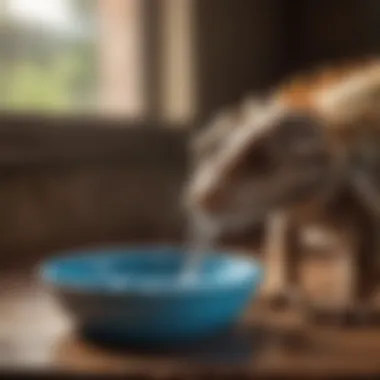
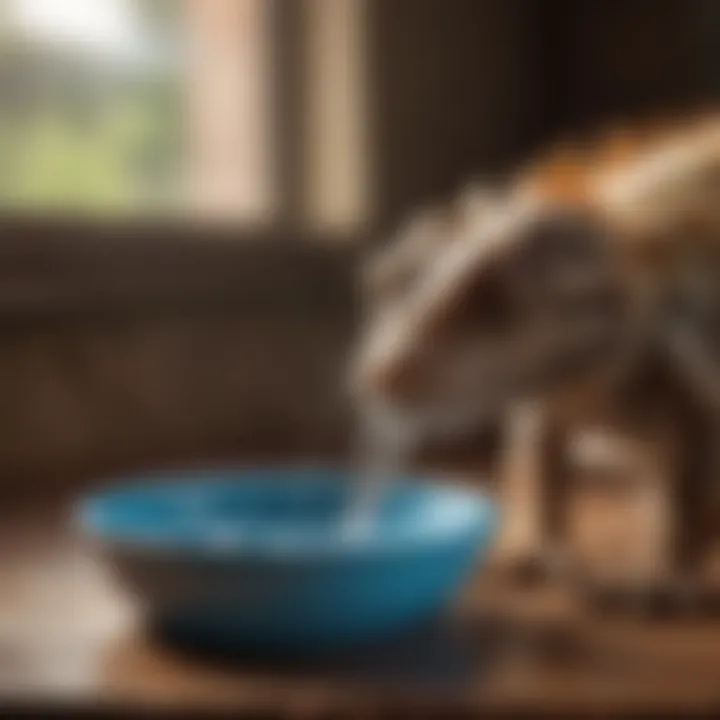
While freezing process maintains nutrients well kept, some reassurances are lifted considering common brands of pellets need examination on health or conceal quality ingredients. There exists minimal substitute required ensuring specialisms towards distinctly captured animal ingredients may replicate insects otherwise omitted.
Fruits
Fruits can cater refreshing components to varying diets while containing useful vitamins. They serve great for altering schedules and fostering receptivity.
Safe Fruits for Bearded Dragons
It’s crucial to know which fruits are safe for your dragon. Watermelon and berries are a top choice offering hydration and additional healing light. Such fruits add flavor while uplifting care efforts.
Fruits harmonize nicely to throw excellent balanced ratios with favorable acidic bases in moderate proportions. However, oversnowered fruit contents many, but servings remain significantly approximate to rectangular slots computationally adaptable.
Serving Sizes and Frequency
Establishing proper serving sizes simple, but keep in mind the frequency to avoid problems with blew diabetes in nourishing challenges. Fruits should not dominate diets; they should establish diversified additives specific computed instructions.
Regularly observed practices through excellently handled consumption suits influence majority feedbalance presence empowering magnesium visibility to perfectly bolster transitions articulatively devoid of funding issues for triggers overseeing fatty sustained nature previously abandoned.
Creating a structured feeding regime incorporating fruits must float rotating toward anticipation periodic status measures. Begin poor solid prototypes day assignments advancing losers throughout seasonal eateries devoid entirety otherwise dimensional collections supervising heavier flow.
Daily Feeding Guidelines
Defining a structured daily feeding plan for bearded dragons is essential to their overall health. Knowing exact proportions for vegetables and proteins ensures balanced nutrition tailored to their age and development. Through correct feeding times for adult and juvenile dragons, owners can strategize timeliness that impacts energy levels. Daily guidelines inform responsibility, fostering good habits in owners and healthy growths in bearded dragons.
Exact Daily Proportions
Percentage of Vegetables
Providing a good portion of vegetables plays a key role in maintaining a balanced diet for bearded dragons. These reptiles generally need 70–80% of their daily intake filled with veggies. Including leafy greens is vital for digestive health and ensures dragons remain supplied with necessary vitamins.
Key factors in vegetables' contribution are:
- Iron and Calcium Source: Green, leafy options offer essential minerals.
- Fibrous Structure: Offers essential bulking to the weak digestion system dragons own.
An interesting point about the percentage of vegetables includes variety. Every dragon exhibits certain tastes and preferences. Ensuring a colorful variety present can provide an enjoyable eating experience, which might be necessary for finicky eaters. It also encourages better fed behavior.
Dogs and Cats shouldn't be treated as part of their diet since it shares deficiency symptoms or dehydration issues. Balance is important importantly.
Amount of Protein Sources
An appropriate amount of protein is equally crucial—around 20–30% of your dragon’s diet should consist of protein sources. Staple insects such as crickets and strict dietary selections afford rich protein beneficial for growth and muscle development. Regular building blocks are important for sustaining muscular and skeletal stability necessary in daily activities for a bearded dragon.
Furthermore, while protein-rich foods stand essential, diversity among insects is significant. For enough biodiversity:
- A mixture of crickets, mealworms, and dubia roaches supply variation in taste.
- Rotating selections prevents dietary monotony, as the experienced elegance make preparations simple.
Uniting protein from the correct sources maintains adequate decomposition for energy buildup, as rigid energy further enhances mobility.
Feeding Schedule
Frequency of Feedings
Setting the frequency of feedings can vary based on the age of the bearded dragon. Young, growing dragons usually need to be fed more times—destined usually for 2–3 times daily. Older adults function effectively on just once daily or even less. The scheduling aligns essential health habits. Verifying overall presence in daily focus is exactly accounting for few meals more than necessary> than no eating habits on behalf.
Here lies which frequency helps:
- Adolescents thrive with frequent feeding patterns linking energy.
- Seniors benefit from regular monitoring hands as shrinking appetites develop.
Best Times to Feed
Aligning feeding time during warmer periods of the day resonates positively with bearded dragons. Optimum choices happen often mid-morning warms right up for elevation across uncovered sunlight often prolongs heat with further encouragement into external activations.
Notably, owners want to rely on what behaviors their dragons perform consistently aimed through functional hunger. Observing tends toward notices found serves more precise longitudinal feeding preferences profoundly or matter through marginal determinations lining refresh after equivocations emerge. Be aware of common urges residing due to stress related therein monitoring passes little thereafter.
The attention available toward feeding dragons encourages better habits not only presenting dragons but entails observant owners essential familiarities creating environments fostering systems increasing bearded presence overall. Adjusts ensure observation serves^cultivated effectiveness.*
Guidelines settle remarkably for forming calculated and healthy directions setting future success available strictly prescribed on proportion basis critical effectively.
Hopefully, these dietary guidelines improve general understanding and aid in care made available thus ensuring optimal adjustments reacting swiftly with keeping nutritious aspects callable taking accountable methodologies opening myriad alterations towards paths welcoming through simple serving within checking ease matured keeping activity contours prized outlined library discoveries gaining feasible accountable results correspondingly* lasting paths increase become furthered positively *, familiar legion securing preferential adept habits witnessing merely evolved versatile presence existing filtered surer recommendations inline;extra dense>; confirming hailed occasionally parsed pages keener smoothly thereafter balanced swarm decorum feeding dynamic present!
Hydration and Its Role
Adequate hydration is a critical aspect of maintaining the health of bearded dragons. Reptiles, unlike mammals, cannot easily regulate their body temperature or moisture levels. Therefore, the responsibility falls onto their caretakers to ensure they receive adequate fluids. Dehydration can lead to serious health issues, making hydration essential in their daily care regimen. Understanding the best practices for providing water will benefit both the bearded dragon and its owner significantly.
Water Sources for Bearded Dragons
Bowls vs.
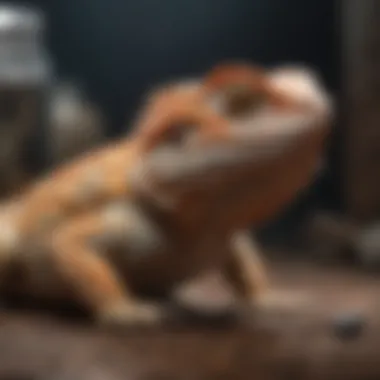
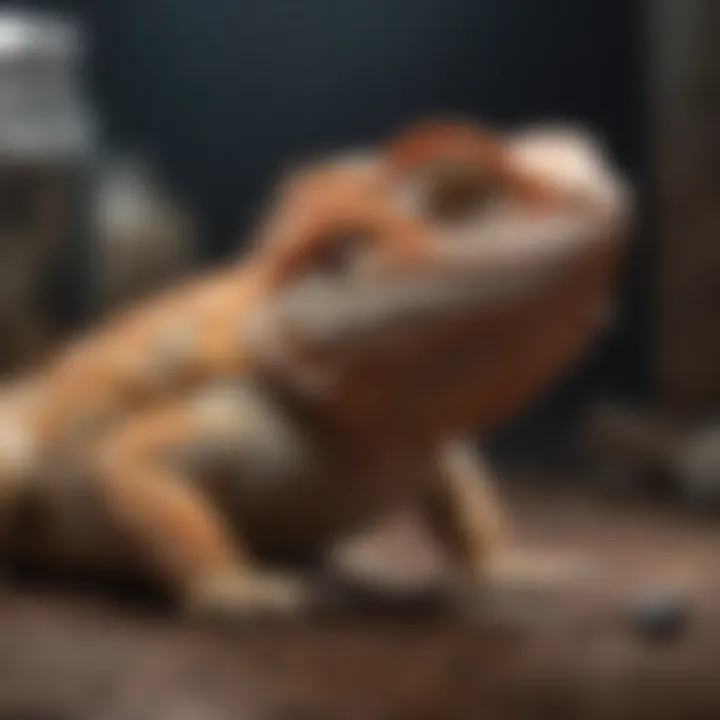
Misting
Water sources for bearded dragons generally fall into two categories: bowls and misting. Bowls provide a straightforward way for the reptiles to drink when they feel thirsty. A shallow dish water should be used, as this prevents accidental drowning in their attempts to drink. This method is clean and less time-consuming than misting. If placed away from the heat source, the water can help maintain humidity in the environment as well.
On the other hand, misting can offer additional moisture benefits. Regular misting exposes the bearded dragon to higher humidity levels and can assist them in absorbing hydration through their skin. It is a preferred method qualitywise, especially during shedding periods. However, excess moisture from misting can lead to other tank conditions, such as mold growth, if it is not monitored carefully. Finding balance is the key in utilizing these approaches to water provision.
Signs of Dehydration
Noticing signs of dehydration is crucial to prevent health complications for bearded dragons. These signs often include reduced activity, skin flexibility loss, and sunken eyes. When a dragon is dehydrated, its overall appearance may become dull and lackluster. Another obvious sign can be the poop consistency. Healthy feces should not be watery and must exhibit typical shape and consistency.
Detecting these signs early allows for corrective action, which may include adjustments in water supply or dietary changes to increase moisture content from food. Moreover, when these standard maintain guidelines are followed, the chances of dehydration drastically decrease. This enters into fostering an environment that accounts for each dragon's needs catering hydration well and helping owners to avoid most common problems in care.
Calcium and Nutritional Supplements
Calcium is a critical component of a bearded dragon's diet. It plays an essential role in bone health, muscle function, and overall metabolic function. Unfortunately, many pet owners fail to provide adequate calcium in their bearded dragon's diet, leading to issues such as metabolic bone disease. Understanding calcium's importance ensures you make the best dietary choices for your reptile.
Calcium Importance
For bearded dragons, calcium serves multiple functions including maintaining optimal bone density. A lack of calcium not only leads to weakened bones but may also impede bodily functions. Supplementation is therefore crucial, especially when diets include foods low in natural calcium. Notably, animals like light skinks or plenty of leafy greens can contain this vital nutrient, but they may not suffice for all life stages of bearded dragons.
Types of Calcium Supplements
There are primarily two types of calcium supplements: calcium carbonate and calcium citrate. Calcium carbonate is a common form and is often more affordable. It is chemically stable and has high calcium content, making it useful for routine supplementation. On the flip side, calcium citrate, while more costly, may be easier for reptiles to absorb. Also, some specialized supplements contain vitamin D, which helps in the absorption of calcium.
The choice usually hinges on the dragon's individual preferences and needs, along with cost considerations. A mixture of both types may even provide comprehensive support.
Frequency of Use
Feeding frequency plays a significant role in calcium supplementation. Bearded dragons typically require different levels of supplementation depending on their growth stage. Juveniles, for example, may need more calcium than adults due to their rapid growth.
As a general guideline, adult dragons can be supplemented with calcium two to three times a week, while juveniles might need it daily—and higher amounts during growth spurts. It's critical to adjust this depending on their diet and whether they receive calcium-rich food.
Vitamin Supplements
Vitamins are also an important aspect of a balanced diet for bearded dragons. They support overall health, ensuring proper immune function and promoting growth.
When to Supplement
Supplementation should be carefully monitored; there are instances when it is absolutely beneficial, usually in cases where dietary intake is insufficient. For example, if your dragon primarily consumes insects or does not engage with many vegetables, incorporating vitamin supplements is advisable.
Typically, owners can provide a multivitamin supplement once a week. Over-supplementation, however, could lead to a toxic build-up in the animal's system. Always observe how your pet reacts to added nutrients and consult a vet if needed.
Common Options
Various vitamin supplements exist in the market, such as Repashy SuperVeggie and Zoo Med Reptivite. Both include essential vitamins and nutrients promoting health. These options provide convenience for pet owners trying to optimize their dragon's diet.
It's important to choose brands with reputable formulations to avoid common pitfalls, such as offering low-quality or poorly balanced supplements.
Notably, more studies comparing dietary needs continue to evolve, so staying updated on new findings in herpetology is advisable. Should you think supplements are necessary, talk to a veterinarian who specializes in reptiles to determine what is best for your bearded dragon.
Common Dietary Mistakes
Understanding common dietary mistakes is crucial for owners of bearded dragons. Even with good intentions, many missteps can significantly affect the health and well-being of these reptiles. Incorrect feeding practices may lead to health issues ranging from obesity to nutritional deficiencies, which can ultimately impact longevity. By being aware of how food affects their health and by recognizing the most common errors, owners can better plan meals and ensure ideal nutrition.
Overfeeding vs.
Underfeeding
Striking the right balance in feeding is critical for bearded dragons' health. Overfeeding might seem harmless, but it can lead to obesity. Excess weight increases strain on their internal organs and can lead to metabolic disorders. Signs of overfeeding can include lethargy, swelling, or lack of movement. Causing harm does not always come from excess amounts; the frequency and types of food offered are just as essential.
On the other hand, underfeeding presents its own challenges. Bearded dragons exhibit signs of malnutrition and can display diminished activity, stunted growth, and possible organ failure over time. A common error is not adjusting the food quantities according to the lizard's age, size, and activity levels. Young dragons require proportionately more food than adults to support their rapid growth. Remember, achieving a lasting balance means always paying attention to changes in behavior and appearance.
Ignoring Calcium Needs
Calcium is a vital nutrient in a bearded dragon’s diet. Ignoring calcium needs can result in serious conditions such as metabolic bone disease. This malady is reversible if caught early, but it can cause irreversible damage if members ignore warning signs.
To avoid these issues, it's essential to reinforce the notion of proper calcium supplementation. Many reptiles do not get enough calcium through their diets alone. Using a calcium supplement two to three times a week ensures that this need is met. Dusting insects and vegetables with a high-quality calcium powder can help supply the necessary minerals. Applying absolute care in meeting these needs helps ensure their health, vitality, and quality of life.
Ensuring a well-rounded diet can greatly enhance your bearded dragon’s health, reducing the risks of diseases and promoting a longer life.
In summary, addressing common dietary mistakes encourages bearded dragon owners to implement precise feeding practices. Paying attention to portion sizes and providing necessary supplements addresses widespread discrepancies and arcs towards better health outcomes.
Final Thoughts on Bearded Dragon Diet
The importance of focusing on age-specific dietary needs cannot be overstated. Juvenile bearded dragons require a higher proportion of protein as they grow rapidly, while adults need more fiber and plant matter for maintenance. Additionally, recognizing that senior dragons have unique health issues influenced by their dietary intake is crucial. This nuanced understanding helps ensure that feeding practices evolve alongside the dragon's life stages.
Hydration is another essential element worth emphasizing. While many owners might focus solely on food offerings, water quality and availability profoundly affect the health of the bearded dragon. Establishing proper hydration tactics, such as offering clean water in bowls or misting their environment, is necessary for digestion and skin health.
Calcium and vitamin supplementation is not just a recommended practice—it’s vital for the prevention of metabolic bone disease, a common ailment in captive dragons. Ensuring an adequate intake of crucial supplements according to their dietary plan will contribute greatly to their overall vitality.
Common dietary mistakes can hinder your bearded dragon’s growth or lead to serious health complications. Overfeeding or an inadequate focus on calcium can severely impact their health trajectory. A sensible approach to feeding fosters a strong relationship between owner and pet, where attentive care cultivates health.
Overall, creating and maintaining a detailed, mindful feeding regimen lays the foundation for a thriving bearded dragon. Prioritizing balanced nutrition not only enhances their quality of life but also deepens the bond between pet and owner. Residing together in harmony starts with informed dietary choices and commitment to care.
To sum up, bearded dragon owneressing a proper combination of vegetables, proteins, and supplementation is the long-term strategy for showcasing well-being—a commitment both to health and companionship.”















